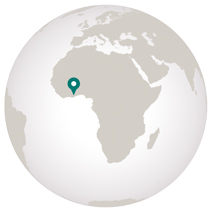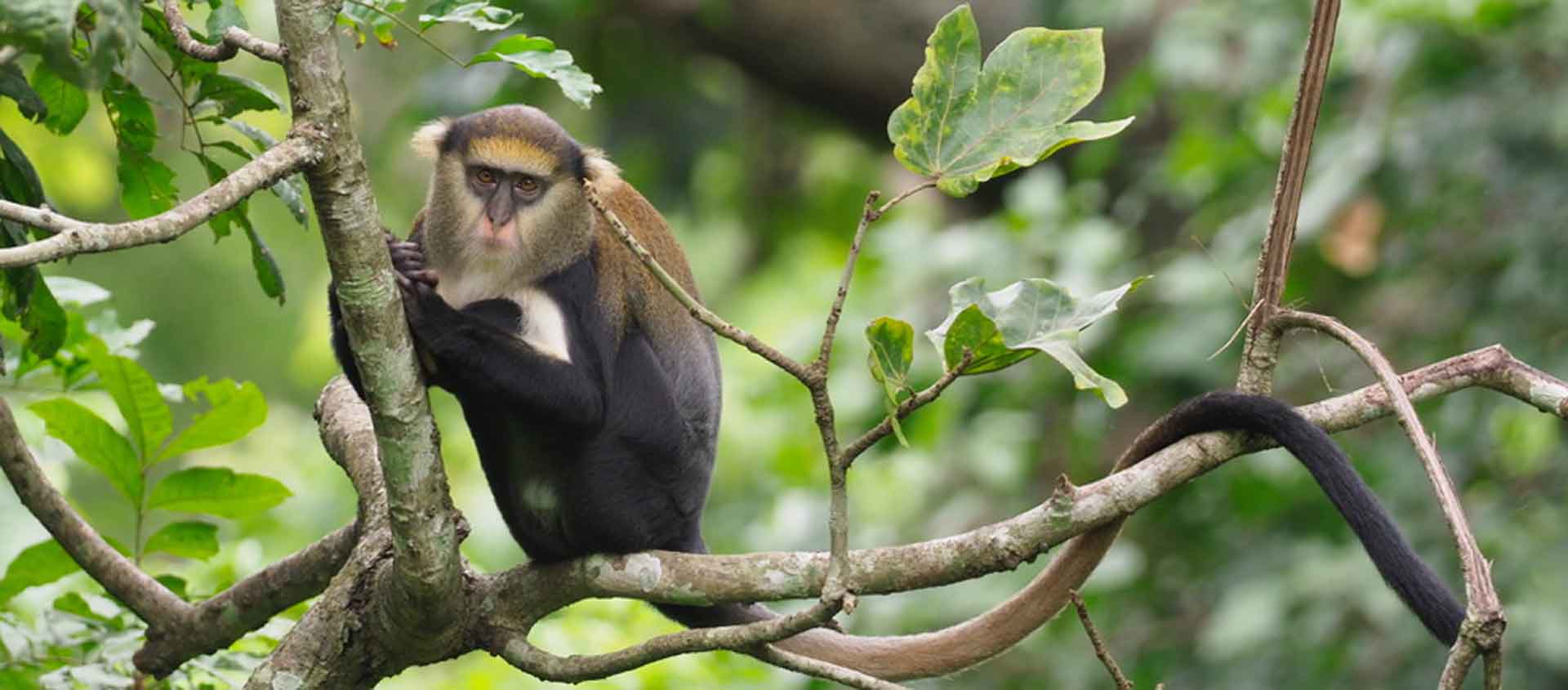Ghana
October 14 – 27, 2025
Ghana Wildlife Tour
Once called the Gold Coast for its plentiful precious metal reserves, Ghana’s landscape is rich in far more than gold. With 16 national parks covering diverse habitats, from coastal wetlands to Upper Guinea Rainforest, Ghana is notable among West African countries for its efforts to conserve its wilderness. And with 12 of the 15 West African Upper Guinea avian endemics, it’s a veritable treasure trove for naturalists, boasting one of Africa’s most sought-after birds, the near-mythical Yellow-headed Picathartes, a phenomenal diversity of butterflies and dragonflies, as well as an array of equally coveted mammals! Join Apex on this two-week Ghana wildlife and birding tour. Scan for turacos and hornbills, barbets and bee-eaters from a canopy walkway spanning West Africa’s best protected old-growth rainforest; thrill to the spectacle of rockfowl at their colony; and accept the challenge of seeking out iconic and elusive rainforest mammals, from pangolins to pottos, civets to anomalures, and so much more.
Destinations
- Travel by Air
- Travel by Road
- Travel by Boat
- Travel by Bullet Train
- Travel by Rail
- Travel by Dog Sled
-
Tuesday, October 14: Arrive Accra, Ghana
Arrive in Accra, the soulful, rapidly modernizing capital of Ghana, and transfer to your hotel. This evening, gather with your fellow travelers and expedition leaders for a welcome dinner and briefing. Dinner and overnight at Labadi Beach Hotel.
-
Wednesday, October 15: Accra / Shai Hills Reserve / Kumasi
After an early breakfast, visit the Shai Hills, not far from the capital, for your first taste of West African wilderness. The highly productive grassland and dry woodland around the bases of the namesake granite inselbergs support a fine array of Guinean savanna birds, notably Blue-bellied and Purple rollers, Double-toothed Barbet, Yellow-crowned Gonolek, Oriole Warbler and the glamorous Guinea and Violet Turacos. Careful scanning of the boulders may also reveal coveys of vocal Stone Partridge and the musical White-crowned Cliff Chat. Mammals are not plentiful but should include troops of Olive Baboons, Green Monkeys, Kob, and perhaps Harnessed Bushbuck.
Once the heat of the day begins, a scenic drive takes you northwards to Kumasi, Ghana’s second largest city and the cultural capital of the former Ashanti Empire. Dinner and overnight at Oak Plaza Suites – Kumasi.
-
Thursday, October 16: Kumasi / Bobiri Forest Reserve
Rise early and head to the small, semi-deciduous tropical rainforest sanctuary of Bobiri, renowned for its butterflies. Although barely 20 square miles in extent, Bobiri offers some heavyweight avian specialties, such as Red-billed and Western Dwarf Hornbills, Purple-throated Cuckooshrike, Red-billed Helmet-shrike, and perhaps even the impressive Congo Serpent Eagle. West African lowland forest birding can be challenging but patience and persistence is always rewarded, and as the heat climbs, the diversity and sheer number of colorful butterflies create a new spectacle. In the late afternoon, watch for African Grey Parrots returning to their roost, and wait for the first nightjars and owls to begin calling. Dinner and overnight at Oak Plaza Suites – Kumasi.
-
Friday, October 17: Kumasi / Bonkro
Drive southwards to the remote village of Bonkro. Set beside a patch of Upper Guinea forest hosting White-necked Rockfowl, Bonkro has become an inspirational model of ecotourism-supported conservation in Ghana. When the rockfowl, also known as Yellow-headed Picathartes, were first discovered here, locals still relied heavily on the forest for bushmeat. Following conservation efforts with local communities, hunters have become guides, assisting wildlife enthusiasts in their quest to see these iconic birds.
Settle into your lodging and set off in the afternoon to one of the known breeding sites of the rockfowl, situated on granite outcrops deep within the forest. These bizarre and prehistoric-looking birds are shy and highly elusive, and almost never encountered during the day, but patiently waiting at their colonies may reward you with one of the ultimate prizes in African ornithology!
After dinner, don your headlamp in preparation for a first crack at another iconic creature. The same hunters-turned-guides of Bonkro have developed a reputation for being able to locate the most sought-after of all mammals, pangolins! Two species of these endangered and highly elusive animals occur here: the smaller, more slender Black-bellied, or Long-tailed, Pangolin, and its heftier White-bellied cousin, also known as the Tree Pangolin. By carefully scanning the rainforest tangles, and listening for the tell-tale sounds of foraging above, you may be lucky enough to encounter one of these truly extraordinary animals. Overnight at 734 Hotel New Edubiase.
-
Saturday, October 18: Bonkro area
The forest fragments around New Edubiase and Bonkro teem with birdlife, and your expedition leaders will determine the best trails and locations from which to search for Western Long-tailed and Western Dwarf Hornbills, Fire-bellied Woodpecker, the elusive Yellow-throated Cuckoo, Forest Wood-hoopoe, and Rufous-sided Broadbill. Even the exceedingly rare Western Wattled Cuckooshrike is a remote possibility, this being its last remaining location in Ghana.
During the morning, keep alert to the possibility of foraging pangolins. Unlike the strictly nocturnal White-bellied Pangolin, Black-bellied Pangolins sometimes extend their activity into the sunlight hours. Butterflies and dragonflies are abundant around forest ponds and streams, and particularly conspicuous as the day warms. After lunch and a midday rest back at your hotel, you may choose to return to Bonkro for a second session with the celebrity rockfowl. Dinner and overnight at 734 Hotel New Edubiase.
-
Sunday, October 19: Bonkro / Kakum National Park
After breakfast, set off toward Ghana’s best-known wilderness area, the jewel in the crown of its protected area network, Kakum National Park. The drive takes you through a largely human-altered landscape of subsistence fields and so-called “farmbush,” a wooded, second-growth habitat that is nevertheless rich in birdlife. At one time, much of Africa’s coastal zone west of the “Dahomey Gap” was covered in a contiguous rainforest belt spanning almost a quarter million square miles. An expanding human population, farming, and logging have fragmented this Upper Guinea forest, with less than a third remaining. Kakum is one such forest “island”, spanning 150 square miles of primary and tall secondary forest, set aside by the British colonial administration as a reserve in 1925 but only formally opened to the public in 1994. Arrive in time for an afternoon exploration near the park headquarters at Abrafo. Dinner and overnight at Rainforest Hotel – Jukwa.
-
Monday, October 20: Kakum National Park
Rise early today to head to Africa’s most famous forest canopy walkway, spanning over 1,000 feet between seven giant forest trees. With special permission for a pre-dawn arrival, we hope to encounter the last of the nocturnal forest denizens, notably the striking, black-and-white, gliding Pel’s Anomalure. Spend the critical morning hours 130 feet above the forest floor, watching the forest come alive from the walkway’s expansive platforms. The gorgeous Black Bee-eater is usually in constant attendance, even perching on the walkway’s rigging; immense Black-casqued, Yellow-casqued, and Brown-cheeked Hornbills wing noisily by; and the surrounding tree canopies are home to Fire-bellied Woodpecker, the striking Blue Cuckooshrike, Violet-backed Hyliota, Crested and Red-headed Malimbes, family parties of Chestnut-capped Flycatcher, and the brilliant Buff-throated Sunbird, to name but a tiny portion of the species on display here. Head back to the lodge for lunch and a rest during the heat of the afternoon, then return to the walkway this evening to look for the rare Brown Nightjar and Fraser’s Eagle Owl. Although Kakum’s list of recorded mammals is a long one, West Africa’s practice of hunting for bushmeat has decimated many wildlife populations but we will nevertheless keep our eyes peeled for primates such as Olive Colobus Monkey, Lowe’s Mona and Lesser Spot-nosed Monkeys, and smaller canopy dwellers like Green Bush Squirrel and African Giant Squirrel. Dinner and overnight at Rainforest Hotel – Jukwa.
-
Tuesday, October 21: Kakum National Park / Ankasa Reserve
After breakfast at the lodge, head west by road to Ankasa Reserve, Ghana’s only wet evergreen rainforest. En route, stop at a series of coastal lagoons and mangroves to search for several birds rarely seen elsewhere in the country, including African Pygmy Goose, White-browed Forest Flycatcher, Orange Weaver, and Reichenbach’s and Brown Sunbirds.
Covering over 200 square miles, Ankasa consists almost entirely of primary growth rainforest, and is the most biologically diverse of its kind in Ghana. It protects over 800 vascular plant species, a phenomenal 650 species of butterfly, and over 200 bird species. Upon arrival in Ankasa, check into your lodge, overlooking the Ankasa River near the entrance to the park. Birding is excellent right at your doorstep, and you may do some this evening, on a quest for Fraser’s and Akun Eagle Owls, and the legendary Nkulengu Rail, with its unmistakable, rhythmic conga drum call. Dinner and overnight at Ankasa Reserve Lodge.
-
Wednesday – Friday, October 22 – 24: Ankasa Reserve
With so many rare and sought-after species to see in Ankasa, days will feel full and action packed. After breakfast, set off in 4x4s to explore the forest. A broad track allows access into the rainforest canopy, where the long list of Upper Guinea endemics and avian specialties includes such sought-after birds as White-breasted Guineafowl, Yellow-throated Olive Greenbul, Rufous-winged Illadopsis, and Red-fronted Antpecker, as well as the more widely distributed but no less sought-after Red-chested Owlet, Dusky Long-tailed Cuckoo, and Forest Scrub Robin. Ponds and swamp backwaters deep in the rainforest hold the exceedingly elusive Spot-breasted Ibis, White-crested Tiger Heron, Hartlaub’s Duck, and both Shining Blue and White-bellied Kingfishers. Scan the sky for the powerful, monkey-eating Crowned Eagle. Diurnal mammals are thin on the ground due to hunting, but after dark, with the help of careful spotlighting and the use of infra-red heat scopes, you may be fortunate to encounter some of the area’s star nocturnal mammals such as West African Potto, Demidoff’s Galago, Western Tree Hyrax, Lord Derby’s Anomalure, Tree Pangolin, and Brush-tailed Porcupine. Dinners and overnights at Ankasa Reserve Lodge.
-
Saturday, October 25: Ankasa Reserve / Cape Coast / Kakum National Park
Enjoy your last morning in Ankasa, before returning to Kakum. Passing along the coast, stop to visit Cape Coast Castle, one of the country’s most infamous edifices, standing as a chilling memorial to the horrors of the trans-Atlantic slave trade. Dinner and overnight at Rainforest Hotel – Jukwa.
-
Sunday, October 26: Kakum National Park
Spend a final day exploring Kakum National Park. Revisit the canopy walkway, or focus on the farmbush and forest edge, where the more open habitat plays home to Ahanta Spurfowl, the handsome Yellow-billed Barbet, Black-and-White Shrike-flycatcher, and a plethora of sunbirds and starlings. Dinner and overnight at Rainforest Hotel – Jukwa.
-
Monday, October 27: Kakum National Park / Accra / Depart
Drive back to Accra, with day rooms at Labadi Beach Hotel. Add to your checklist one last time and toast to a successful journey at a farewell lunch, before heading to the airport for your international flights home.
Details
- October 14 – 27, 2025
- Leaders Jonathan Rossouw & Joffers (Jonathan) McCormack
- $12,570 Per Person Rate
- $21,370 Solo Rate
- 14 days Trip Length
- 10 guests
- Accra Start/End
Call us to reserve your spot on this exciting expedition!








